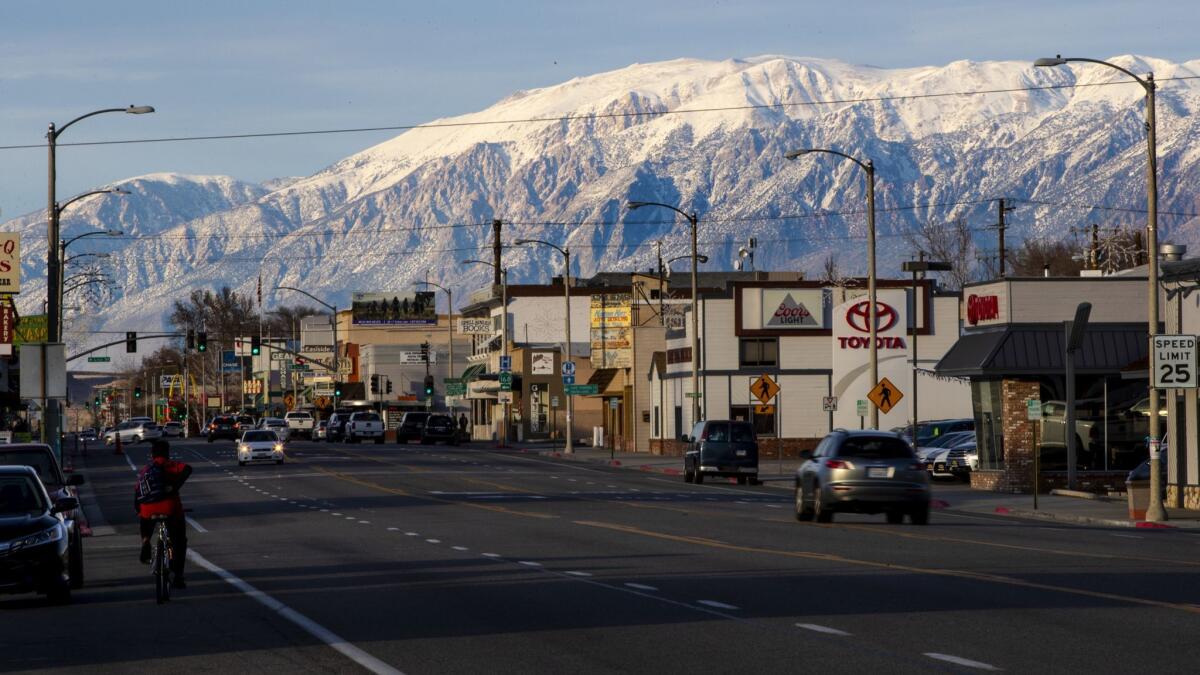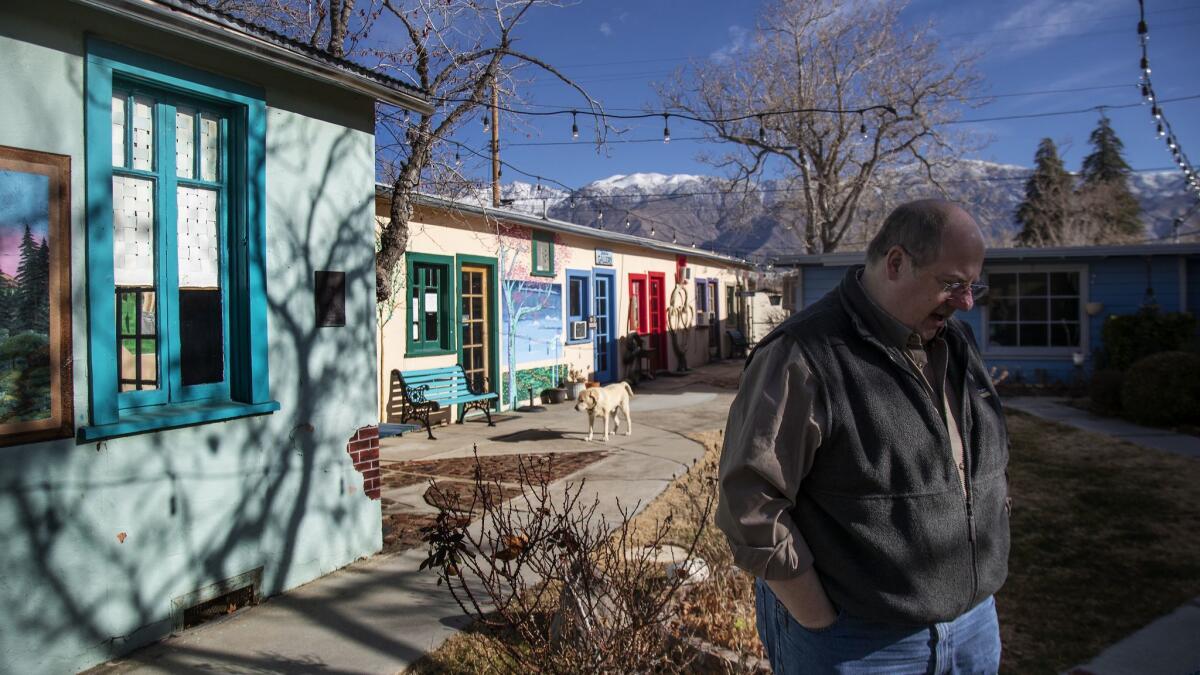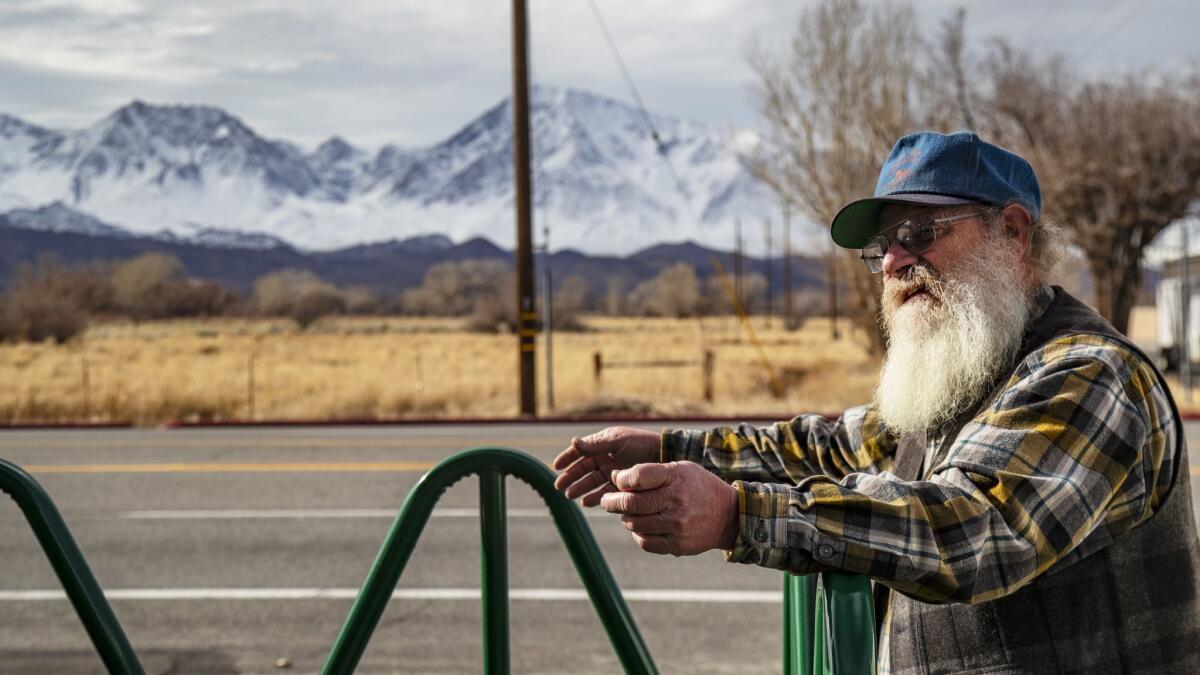Owens Valley gushes over Department of Water and Power land plan

Reporting from Lone Pine, Calif. — Angelenos bearing gifts have elicited skepticism in Owens Valley since the early 1900s, when city agents posed as ranchers and farmers to buy land and water rights and then built dams and diversions that turned much of the region into an acrid dust bowl.
The scandal dramatized in the classic 1974 film “Chinatown” also transformed local business owners into lessees paying rent to an overbearing landlord 180 miles to the south.
Now, the Los Angeles Department of Water and Power is extending an olive branch. The department has proposed selling some of the commercial property it leases – but not the water rights – to dozens of lessees in the financially struggling towns along a rustic, 112-mile stretch of Highway 395 between the eastern Sierra Nevada range and the White-Inyo Mountains.
It’s not clear whether the proposal unveiled earlier this month will ultimately yield fruitful negotiations, but initial skepticism in Olancha, Lone Pine, Big Pine, Independence and Bishop is giving way to genuine excitement.
The advantages of owning commercial property in Owens Valley are cultural as well as economic. In addition to creating an incentive for investing in improvements, it would fulfill a longing to reclaim land many believe had been taken away.
“Are we excited about this proposal? Oh yeah!” Jeff Griffiths, an Inyo County Supervisor whose district includes Bishop, said. “The opportunity to own your property is something folks around here have only dreamed about for a very long time.”

“The DWP’s leasing process has decimated our regional economy and overall community spirit,” he added, “because there is not much incentive to invest in a business property that can’t be resold.”
Anselmo Collins, water operations manager for the DWP, which today controls 25% of the Owens Valley floor, said the agency’s motivation “is simply this: We’ve made a determination that we no longer have a need to own these properties. That’s a shift from the time when they were purchased many years ago and our goal was to protect Los Angeles’ water rights and the watershed.”
“Our focus now is on individuals in Owens Valley who want more control over their own destinies — and less oversight by the DWP,” he added. “We’re not looking to make a whole bunch of money, just to divest some of the property that currently belongs to the city of L.A.”
DWP officials expect to present a final draft of the proposal to the Los Angeles City Council for approval within a few months and then begin conducting appraisals to determine the fair market values of 57 properties targeted for divestiture.
If all goes according to plan, officials said, the DWP will begin selling off those lots by year’s end.
“When we first heard about this proposal, we thought, ‘Wait. This isn’t the DWP we’re familiar with,” recalled Travis Powell, a board member of the Lone Pine Film History Museum, which leases about 3 acres of commercial property including an aging rodeo facility. “Now, we’re very interested, depending on the asking price, of course.”
About 60 miles to the north, in Bishop, Mike Allen said he’s ready to make a deal on the land beneath his business, Sierra Saddlery: Western Wear, Feed and Supplies.
“Fifteen years ago, I drew up plans for more office space and a warehouse,” said Allen, nodding toward shelves loaded with products ranging from propane tanks to RV parts. “There’s so little room left in this place, I do my bills and product orders on the sales counter between customers.”

The DWP’s current charter requires that its commercial properties be put up for competitive bid in auction before they change ownership. The new proposal, however, would operate under terms of the state Charles Brown Act, which grants lessees right of first refusal before the lease goes out to bid, but applies only if an entity owns more than 50% of private land in another county.
Los Angeles owns about 251,958 acres, or about 89%, of the private land in Inyo County. The undeveloped acreage includes blue-ribbon trout streams, sharp-edged lava cliffs, rugged canyon lands scoured by wind and rain, marshlands and desert plains.
The proposal would exclude sales of DWP properties that include an existing waterway such as a canal, and forbid sales to DWP employees and government agencies, officials said. In addition, a lessee must have operated their business on city land for at least two of the past three years.
It remains to be seen how many DWP parcels change hands in Inyo County, where the department contributes about $20 million annually in property taxes, or about 20% of the county budget.
The agency has a long history of failed promises — and violent confrontations — in the region.
In 1997, the DWP agreed to relinquish 75 acres in the Owens Valley for residential and commercial uses. But only a handful of lots from those 75 acres have changed hands because the agency tends to set minimum bids far above market value.
In 2004, then-Mayor James K. Hahn proposed an unsuccessful plan to create a land conservancy that would retain the city’s water rights but ban any future development on 500 square miles of the Owens River Valley. The move was intended to preserve the region’s natural beauty, archaeological sites and general uses: fishing, hunting, hiking and grazing by local ranchers.

In 2010, a DWP proposal to put solar panels on 80 square miles of dry lake bed and flatlands east of the Sierra Nevada range ran into a fatal engineering problem: extremely caustic mud.
Now, the county has launched eminent domain proceedings to take control of a landfill in Bishop it has leased from the agency for decades. That effort was triggered after the DWP in 2017 proposed a new lease that included a fourfold rent increase of more than $20,000 annually and a clause allowing the DWP to terminate the agreement for any reason with 180 days’ notice.
Then there’s John Miller, 68, owner of Miller’s Towing & Tires, which operates out of a vintage red Quonset hut made of corrugated steel on the southern outskirts of Lone Pine.
“Several times over the past 38 years I’ve pleaded with the DWP to sell me the land so that I could make a few costly and sorely needed improvements,” he said, shaking his head. “But their response was just a big fat, ‘No.’ ”
Watching weekenders speeding past toward ski resorts including Mammoth Mountain, Miller pointed with his thumb over his shoulder and added, “If this proposal goes through, first thing I’ll do is throw away this building.”
More to Read
Sign up for Essential California
The most important California stories and recommendations in your inbox every morning.
You may occasionally receive promotional content from the Los Angeles Times.











